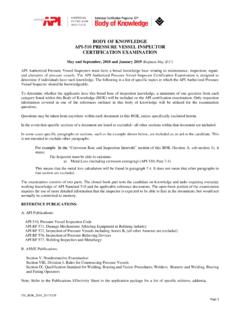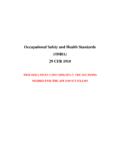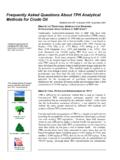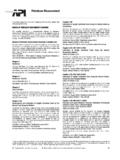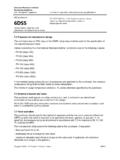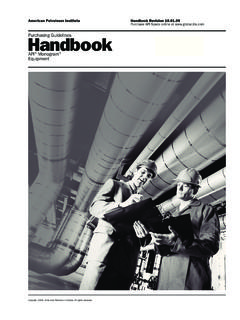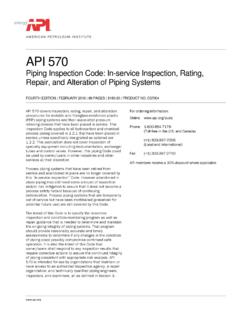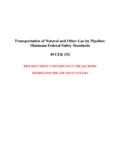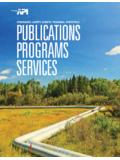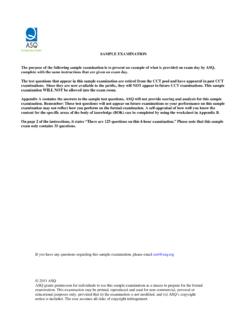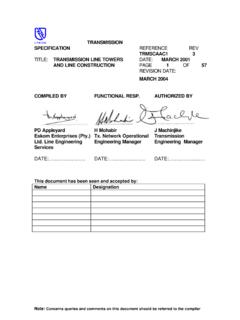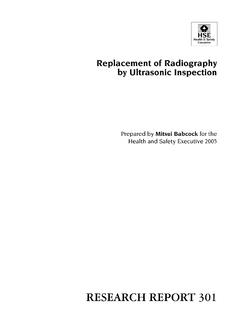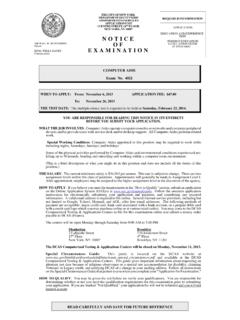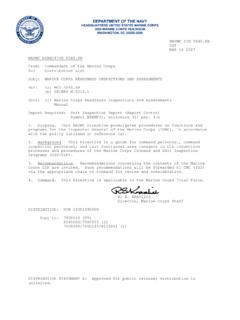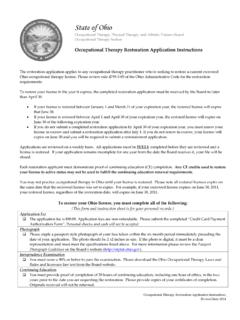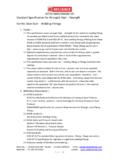Transcription of BODY OF KNOWLEDGE API-653 ABOVEGROUND STORAGE …
1 BODY OF KNOWLEDGE . API-653 ABOVEGROUND STORAGE TANK inspector . CERTIFICATION examination . November 2017, March 2018 and July 2018 (Replaces May 2016). API Authorized ABOVEGROUND STORAGE Tank Inspectors must have a broad KNOWLEDGE base relating to tank inspection and repair of ABOVEGROUND STORAGE tanks . The API ABOVEGROUND STORAGE Tank inspector Certification examination is designed to identify individuals who have satisfied the minimum qualifications specified in API. Standard 653, Tank Inspection, Repair, Alteration, and Reconstruction.
2 Questions may be taken from anywhere within each document in this Body of KNOWLEDGE (BOK), unless specifically excluded herein. In the event that specific sections of a document are listed as excluded all other sections within that document are included. In some cases specific paragraphs or sections, such as the example shown below, are included as an aid to the candidate. This is not intended to exclude other paragraphs. For example: In the Corrosion Rate and Inspection Intervals section of this BOK (Section A, sub-section 1), it states: The inspector must be able to calculate: a) Metal Loss (including corrosion averaging - API-653 , Section 4).
3 This means that the metal loss calculation will be found in Section 4. It does not mean that other sections in that document are excluded. The examination consists of two parts. The closed-book part tests the candidate on KNOWLEDGE and tasks requiring everyday working KNOWLEDGE of API Standard 653 and the applicable reference documents. The open-book portion of the examination requires the use of more detailed information that the inspector is expected to be able to find in the documents, but would not normally be committed to memory.
4 REFERENCE PUBLICATIONS: A. API Publications API Recommended Practice 571, Damage Mechanisms Affecting Equipment in Refining Industry API Recommended Practice 575, Inspection of Atmospheric and Low-Pressure STORAGE tanks API Recommended Practice 577, Welding Inspection and Metallurgy API Standard 650, Welded Steel tanks for Oil STORAGE API Recommended Practice 651, Cathodic Protection of ABOVEGROUND Petroleum STORAGE tanks API Recommended Practice 652, Lining of ABOVEGROUND Petroleum STORAGE Tank Bottoms API Standard 653, Tank Inspection, Repair, Alteration.
5 And Reconstruction B. ASME Publications American Society of Mechanical Engineers (ASME) Boiler & Pressure Vessel Code: Section V, Nondestructive examination Section IX, Qualification Standard for Welding, Brazing and Fusion Procedures; Welders; Brazers; and Welding, Brazing and Fusing Operators Note: Refer to the Publications Effectivity Sheet in the application package for a list of which editions, addenda, and supplements of the reference publications are effective for your exam. 05/17. Page 1 of 12. 653_BOK_2017. CALCULATIONS & TABULAR EVALUATIONS FOR EVALUATING THICKNESS MEASUREMENTS, WELD SIZES, AND TANK INTEGRITY.
6 (NOTE: Paragraph references for all formulas and calculations listed here should be checked for accuracy to the edition, addenda, or supplement for the examination you plan to take per the Publication Effectivity Sheet in the API. examination Application.). NOTE: Candidates are expected to be able to understand SI units (metric system) and the US customary units (inches, feet, PSI, etc.) and to use both system formulas. A. Calculation questions will be oriented toward existing tanks , not new tanks . API Authorized AST Inspectors should be able to check and perform calculations included in the following categories: 1.
7 CORROSION RATES AND INSPECTION INTERVALS (API-575, Paragraph ). The inspector should be able to take inspection data and determine the internal and external inspection intervals. These calculations could be in either the open book or closed book portion of the exam. The inspector must be able to calculate: a) Metal Loss (including corrosion averaging ( API-653 , Section 4). b) Corrosion Rates c) Remaining Life d) Remaining Corrosion Allowance e) Inspection Interval ( API-653 , Section 6). Remaining life (years) = t actual - t minimum corrosion rate [inches (millimeters) per year].
8 Where: t actual = the thickness, in inches (millimeters), recorded at the time of inspection for a given location or component. t minimum = minimum allowable thickness, in inches (millimeters), for a given location or component. Corrosion rate = t previous - t actual years between t actual and t previous t previous = the thickness, in inches (millimeters), recorded at the same location as t actual measured during a previous inspection. The formulas for performing the above calculations and rules for setting the inspection intervals may be "closed- book" during the exam.
9 The inspector should also be able to compensate for the corrosion allowance. (Add or subtract based on requirements from the exam problem.). 2. JOINT EFFICIENCIES. The inspector must be able to determine the joint efficiency, "E", of a tank weld. inspector should be able to determine: a) Joint Types ( API-653 Section 4, Table 4-2). b) Type and extent of radiography performed (API 653, Table 4-2, Section 12; API 650, Section , Figure 8- 1). c) Joint efficiency by reading API-653 , Table 4-2. 05/17. Page 2 of 12. 653_BOK_2017. Determining joint efficiency may be part of a minimum thickness or maximum fill height problem since joint efficiency, "E", is used in the formulas for determining required thickness.
10 ( API-653 , ). 3. MAXIMUM FILL HEIGHT (HYDROSTATIC TESTING). The inspector should be able to determine the maximum liquid height for a tank. To determine the height, the t min . formula in API-653 is rearranged as follows. This formula will be provided in the exam. The inspector is NOT. expected to derive this formula by using transposition. a) Calculate the minimum allowable thickness per Section 4 of API 653 or the maximum fill height in the localized corroded area per: S E t min . H . D G . b) Calculate the minimum allowable thickness per Section 4 of API 653 or the maximum fill height for an entire shell course per: S E t min.
